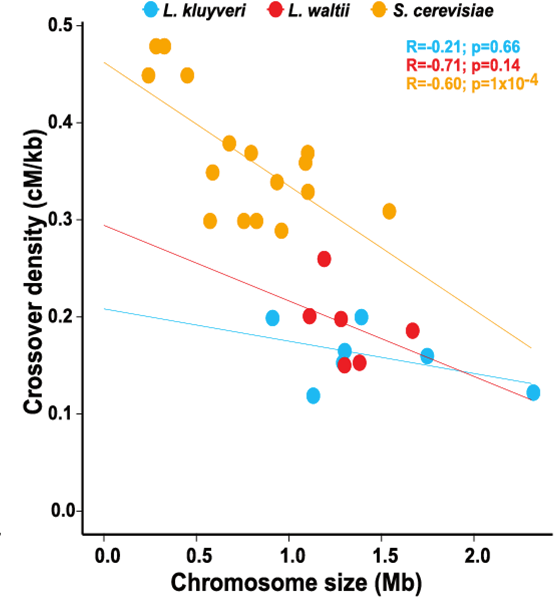Lessons from the meiotic recombination landscape of the ZMM deficient budding yeast Lachancea waltii.
Fabien Dutreux, Abhishek Dutta, Emilien Peltier, Sabrina Bibi-Triki, Anne Friedrich, Bertrand Llorente, Joseph Schacherer.
PLoS Genet. 2023. doi:10.1371/journal.pgen.1010592
Meiotic recombination is a driving force for genome evolution, deeply characterized in a few model species, notably in the budding yeast Saccharomyces cerevisiae. Interestingly, Zip2, Zip3, Zip4, Spo16, Msh4, and Msh5, members of the so-called ZMM pathway that implements the interfering meiotic crossover pathway in S. cerevisiae, have been lost in Lachancea yeast species after the divergence of Lachancea kluyveri from the rest of the clade. In this context, after investigating meiosis in L. kluyveri, we determined the meiotic recombination landscape of Lachancea waltii. Attempts to generate diploid strains with fully hybrid genomes invariably resulted in strains with frequent whole-chromosome aneuploidy and multiple extended regions of loss of heterozygosity (LOH), which mechanistic origin is so far unclear. Despite the lack of multiple ZMM pro-crossover factors in L. waltii, numbers of crossovers and noncrossovers per meiosis were higher than in L. kluyveri but lower than in S. cerevisiae, for comparable genome sizes. Similar to L. kluyveri but opposite to S. cerevisiae, L. waltii exhibits an elevated frequency of zero-crossover bivalents. Lengths of gene conversion tracts for both crossovers and non-crossovers in L. waltii were comparable to those observed in S. cerevisiae and shorter than in L. kluyveri despite the lack of Mlh2, a factor limiting conversion tract size in S. cerevisiae. L. waltii recombination hotspots were not shared with either S. cerevisiae or L. kluyveri, showing that meiotic recombination hotspots can evolve at a rather limited evolutionary scale within budding yeasts. Finally, L. waltii crossover interference was reduced relative to S. cerevisiae, with interference being detected only in the 25 kb distance range. Detection of positive inference only at short distance scales in the absence of multiple ZMM factors required for interference-sensitive crossovers in other systems likely reflects interference between early recombination precursors such as DSBs.

